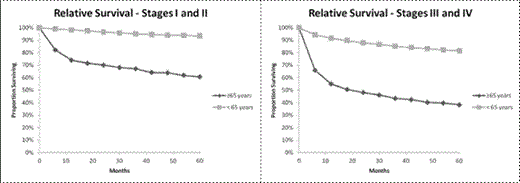Classical Hodgkin Lymphoma (cHL) is a highly curable malignancy in young adults. Most of the information available on natural history and management of cHL comes from series and clinical trials in young patients. There is limited information on the outcomes of older patients with cHL
We analyzed the characteristics and outcomes of a large contemporary cohort of cHL patients ≥ 65 years diagnosed in the US and reported to the Surveillance Epidemiology and End Results program (SEER-18). Inclusion criteria consisted of diagnosis of cHL as first malignant neoplasm, year of diagnosis 2000-2010, known stage and known race. Cases reported from death certificate or autopsy only were excluded. Information retrieved contained age at diagnosis, year of diagnosis, race, sex, histological subtype, stage, presence of extra-nodal disease and survival time. Characteristics of cHL in patients ≥ 65 years (older) were compared to those < 65 years (younger). We subsequently estimated relative survival (RS) for different stages and age strata among older patients comparing with outcomes in younger patients.
There were 20815 cases of cHL reported during the period with median follow up of 48 months, including 2884 (13.8%) cases in older patients. Older patients were more likely to present with extra-nodal disease (4.7% vs. 2.2%, P< 0.001), advanced stage (52.6% vs. 37.3%, P<0.001) and with lymphocyte depleted cHL (3.3% vs. 0.9%) or mixed cellularity cHL (22.5% vs. 11.3%, P<0.001) than younger patients. Additionally, older cHL patients with early stage disease were less likely to receive radiation therapy (35.6% vs. 48.2%, P<0.001). RS at one year (64% vs. 95.7%, P<001) and 5-years (49% vs. 89%, P<0.001) was much inferior in older than in younger patients, even when stratified by early (I and II) and advanced (III and IV) stages (Figure). RS deteriorated quickly with increasing age at diagnosis. One year RS was 73.9%, 56.3% and 43.3% and 5-years RS was 57.9%, 41.6% and 30.4% for patients 65-74, 75-84 and 85+ years, respectively. Even with adjustment for histology, sex, year of diagnosis and race, patients 65-74 years (HR = 4.81, 95%CI 4.41-5.26, P<0.001) 75-84 years (HR = 9.60, 95% CI 8.78-10.49, P<0.001) and 85+ years (HR = 16.19, 95% CI 14.15-18.51, P<0.001) were at a much higher risk of death than younger cHL patients.
cHL has distinct presentation and far worse prognosis in older patients with excessive early (<1 year) mortality. There is a need to further understand patterns of treatment failure and develop age-specific therapeutic interventions for this group.
No relevant conflicts of interest to declare.
Author notes
Asterisk with author names denotes non-ASH members.


